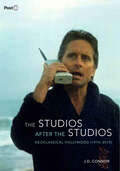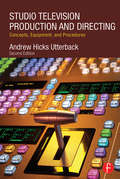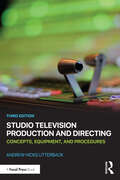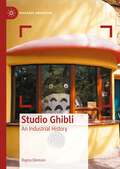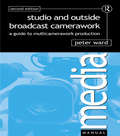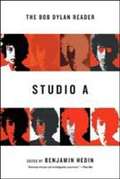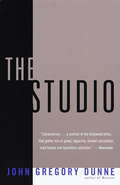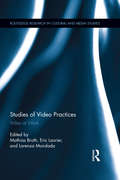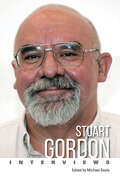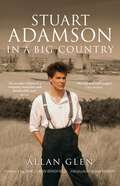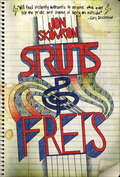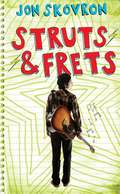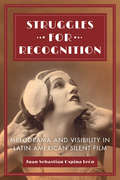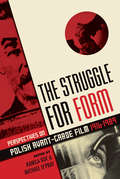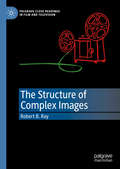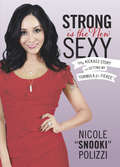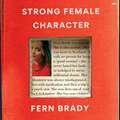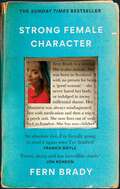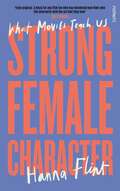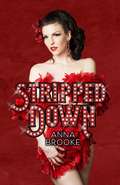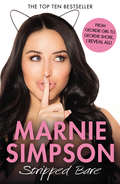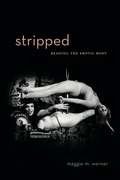- Table View
- List View
The Studios after the Studios: Neoclassical Hollywood (1970-2010)
by J. D. ConnorModern Hollywood is dominated by a handful of studios: Columbia, Disney, Fox, Paramount, Universal, and Warner Bros. Threatened by independents in the 1970s, they returned to power in the 1980s, ruled unquestioned in the 1990s, and in the new millennium are again beseiged. But in the heyday of this new classical era, the major studios movies — their stories and styles — were astonishingly precise biographies of the studios that made them. Movies became product placements for their studios, advertising them to the industry, to their employees, and to the public at large. If we want to know how studios work—how studios think—we need to watch their films closely. How closely? Maniacally so. In a wide range of examples, The Studios after the Studios explores the gaps between story and backstory in order to excavate the hidden history of Hollywood's second great studio era.
Studio Television Production and Directing: Concepts, Equipment, and Procedures
by Andrew UtterbackMaster the fundamentals of studio production procedure and become an effective leader on set. Gain fluency in essential studio terms and technology and acquire the skills you need to make it in the industry. Elegant, accessible, and to the point, the second edition of Andrew H. Utterback’s Studio Television Production and Directing is your back-to-the-basics guide to studio-based lighting, set design, camera operations, floor direction, technical direction, audio capture, graphics, prompting, and assistant directing. Whether you are an established studio professional or a student looking to enter the field, this book provides you with the technical expertise you need to successfully coordinate live or taped studio television in the digital age. This new edition has been updated to include: A UK/Euro focused appendix, enhancing the book’s accessibility to students and professionals of television production around the world An advanced discussion of the job of the Director and the Command Cue Language Fresh discussion of tapeless protocols in the control room, Media Object Server newsroom control software (iNews), editing systems, switcher embedded image store, and DPM (DVE) Brand new sections on UHDTV (4K), set design, lighting design, microphones, multiviewers, media asset management, clip-servers, and the use of 2D and 3D animation Expanded coverage of clip types used in ENG and video journalism (VO, VO/SOT, and PKG) An all new companion website (www.focalpress.com/cw/utterback) with pre-recorded lectures by the author, sample video clips, an expanded full color image archive, vocabulary flashcards, and more Note: the companion website is still under development, but in the meantime the author's filmed lectures are all freely available on Youtube: https://www.youtube.com/channel/UCRp_aSpO0y8cDqLjFGZ2s9A
Studio Television Production and Directing: Concepts, Equipment, and Procedures
by Andrew Hicks UtterbackThis updated third edition of Studio Television Production and Directing introduces readers to the basic fundamentals of studio and control room production. Accessible and focused, readers of this updated third edition will learn about essential studio and control room terminology and the common technology package. This book is your back-to-the-basics guide to common technology—including principles of directing, assistant directing, technical directing, playback, audio ops, basic studio lighting, an introduction to set design, camera ops, floor directing, story types (VO, VO/SOT, PKG), basic engineering, and more. Whether an established professional or a student, this book provides readers with the technical expertise to successfully coordinate live or recorded multicamera production. In this new edition, author Andrew Hicks Utterback offers an expanded glossary and new material on visualization walls, alternative camera mounts, basic engineering, and news narrative diagramming.
Studio Ghibli: An Industrial History (Palgrave Animation)
by Rayna DenisonStudio Ghibli: An Industrial History takes us deep into the production world of the animation studio co-founded by Oscar-winning director Hayao Miyazaki. It investigates the production culture at Studio Ghibli and considers how the studio has become one of the world’s most famous animation houses. The book breaks with the usual methods for studying Miyazaki and Ghibli’s films, going beyond textual analysis to unpack the myths that have grown up around the studio during its long history. It looks back at over 35 years of filmmaking by Miyazaki and other Ghibli directors, reconsidering the studio’s reputation for egalitarianism and feminism, re-examining its relationship to the art of cel and CG animation, investigating Studio Ghibli’s work outside of feature filmmaking from advertising to videogames and tackling the studio’s difficulties in finding new generations of directors to follow in the footsteps of Miyazaki and Isao Takahata. By reconstructing the history of Studio Ghibli through its own records, promotional documents and staff interviews, Studio Ghibli: An Industrial History offers a new perspective not just on Ghibli, but on the industrial history of Japanese animation.
Studio and Outside Broadcast Camerawork: A Guide To Multi-camerawork Production
by Peter WardStudio and outside broadcast is often done with more than one camera and has its own distinct discipline and operational procedures. Many camera operators now start with single camera operations and have little or no experience of the skills required for multi-camera operation, whereas it used to be the other way round. This book prepared newcomers to multi-camerawork and the techniques required to produce professional results. Studio and Outside Broadcast Camerawork is a revised edition of Multi-Camera Camerawork, including new material on widescreen shooting and an update on BBC (and worldwide) policy of 'shoot and protect' for dual aspect ratio format production.
Studio A: The Bob Dylan Reader
by Benjamin HedinThis book presents Bob Dylan's unique literary legacy in a collection that gathers over fifty articles, poems, essays, speeches, literary criticisms, and interviews; many previously unpublished.
The Studio
by John Gregory DunneIn 1967, John Gregory Dunne asked for unlimited access to the inner workings of Twentieth Century Fox. Miraculously, he got it. For one year Dunne went everywhere there was to go and talked to everyone worth talking to within the studio. He tracked every step of the creation of pictures like "Dr. Dolittle," "Planet of the Apes," and "The Boston Strangler." The result is a work of reportage that, thirty years later, may still be our most minutely observed and therefore most uproariously funny portrait of the motion picture business.Whether he is recounting a showdown between Fox's studio head and two suave shark-like agents, watching a producer's girlfriend steal a silver plate from a restaurant, or shielding his eyes against the glare of a Hollywood premiere where the guests include a chimp in a white tie and tails, Dunne captures his subject in all its showmanship, savvy, vulgarity, and hype. Not since F. Scott Fitzgerald and Nathanael West has anyone done Hollywood better."Reads as racily as a novel...(Dunne) has a novelist's ear for speech and eye for revealing detail...Anyone who has tiptoed along those corridors of power is bound to say that Dunne's impressionism rings true."--Los Angeles Times
Studies of Video Practices: Video at Work (Routledge Research in Cultural and Media Studies #63)
by Mathias Broth Eric Laurier Lorenza MondadaThe last two decades have seen a rapid increase in the production and consumption of video by both professionals and amateurs. The near ubiquity of devices with video cameras and the rise of sites like YouTube have lead to the growth and transformation of the practices of producing, circulating, and viewing video, whether it be in households, workplaces, or research laboratories. This volume builds a foundation for studies of activities based in and around video production and consumption. It contributes to the interdisciplinary field of visual methodology, investigating how video functions as a resource for a variety of actors and professions.
Stuart Gordon: Interviews (Conversations with Filmmakers Series)
by Michael DoyleAnimated by a singularly subversive spirit, the fiendishly intelligent works of Stuart Gordon (1947–2020) are distinguished by their arrant boldness and scab-picking wit. Provocative gems such as Re-Animator, From Beyond, Dolls, The Pit and the Pendulum, and Dagon consolidated his fearsome reputation as one of the masters of the contemporary horror film, bringing an unfamiliar archness, political complexity, and critical respect to a genre so often bereft of these virtues. A versatile filmmaker, one who resolutely refused to mellow with age, Gordon proved equally adept at crafting pointed science fiction (Robot Jox, Fortress, Space Truckers), sweet-tempered fantasy (The Wonderful Ice Cream Suit), and nihilistic thrillers (King of the Ants, Edmond, Stuck), customarily scrubbing the sharply drawn lines between exploitation and arthouse cinema.The first collection of interviews ever to be published on the director, Stuart Gordon: Interviews contains thirty-six articles spanning a period of fifty years. Bountiful in anecdote and information, these candid conversations chronicle the trajectory of a fascinating career—one that courted controversy from its very beginning. Among the topics Gordon discusses are his youth and early influences, his founding of Chicago’s legendary Organic Theatre (where he collaborated with such luminaries as Ray Bradbury, Kurt Vonnegut, and David Mamet), and his transition into filmmaking where he created a body of work that injected fresh blood into several ailing staples of American cinema. He also reveals details of his working methods, his steadfast relationships with frequent collaborators, his great love for the works of Lovecraft and Poe, and how horror stories can masquerade as sociopolitical commentaries.
Stuart Adamson: In a Big Country
by Glen AllanA music journalist and fan examines the life and work of the Scottish guitarist, vocalist, and songwriter. The book that fans of the Skids, Big Country and the Raphaels have been waiting for—a critical perspective not only of Adamson&’s music and its wider cultural influence, but also the excesses of fame and how the music business really works. Stuart Adamson: In A Big Country tells the story of how a teenager who was raised in a small Fife village released his first single at 19, wrote three Top 40 albums in the next three years and was written off as a has-been at 23, but then went on to form a new band and sell more than 10 million records worldwide, touring with the Rolling Stones and David Bowie. Although Adamson was one of the most respected and popular figures in the music industry, his personal life was complex and ultimately tragic, ending with his alcohol-fueled suicide in a Hawaiian hotel in December, 2001.&“He was a massive, massive influence on me . . . Absolute genius.&” —James Dean Bradfield, Manic Street Preachers&“An overdue tribute to a visionary musician and honorable man.&” —Keith Cameron, Mojo&“Engaging journey through the peaks and troughs of an ultimately troubled life . . . Moving and well-judged.&” —Rob Hughes, The Word
Struts & Frets
by Jon SkovronMusic is in Sammy’s blood. His grandfather was a jazz musician, and Sammy’s indie rock band could be huge one day—if they don’t self-destruct first. Winning the upcoming Battle of the Bands would justify all the band’s compromises and reassure Sammy that his life’s dream could become a reality. But practices are hard to schedule when Sammy’s grandfather is sick and getting worse, his mother is too busy to help either of them, and his best friend may want to be his girlfriend. When everything in Sammy’s life seems to be headed for major catastrophe, will his music be enough to keep him together?
Struts and Frets
by Jon SkovronTold in a voice that's honest, urgent, and hilarious, "Struts and Frets" is a bright debut novel about forming a band, falling in love, and facing the truth.
Struggles for Recognition: Melodrama and Visibility in Latin American Silent Film
by Juan Sebastián Ospina LeónStruggles for Recognition traces the emergence of melodrama in Latin American silent film and silent film culture. Juan Sebastián Ospina León draws on extensive archival research to reveal how melodrama visualized and shaped the social arena of urban modernity in early twentieth-century Latin America. Analyzing sociocultural contexts through film, this book demonstrates the ways in which melodrama was mobilized for both liberal and illiberal ends, revealing or concealing social inequities from Buenos Aires to Bogotá to Los Angeles. Ospina León critically engages Euro-American and Latin American scholarship seldom put into dialogue, offering an innovative theorization of melodrama relevant to scholars working within and across different national contexts.
The Struggle for Form
by Kamila KucThis is the first comprehensive English-language account of the Polish avant-garde film, from its beginnings in the early decades of the last century to the collapse of communism in 1989. Taking a broad understanding of avant-garde film, this collection includes writings on the pioneering work of the internationally-acclaimed Franciszka and Stefan Themerson; the Polish Futurists' (Jalu Kurek, Anatol Stern) engagement with film; the Thaw and animation (Jan Lenica and Walerian Borowczyk, Andrzej Pawlowski, Zbigniew Rybczynski); documentary (Natalia Brzozowska, Kazimierz Karabasz, Wojciech Wiszniewski), Polish émigré filmmakers (Roman Polanski, Jerzy Skolimowski, Andrzej Zulawski) as well as essays and documentation on the highly influential Film Form Workshop (Józef Robakowski, Ryszard Wasko, Wojciech Bruszewski). Including a mix of historical writings from early film magazines with commissioned essays, this book constitutes an important source on the rich, complex and diverse history of the Polish film avant-garde, which is presented from the perspective of both British (A. L. Rees, Jonathan Owen, Michael O'Pray) and Polish (Marcin Gizycki, Ryszard Kluszczynski, Kamila Kuc) authorities on the subject. This book is thus an indispensable introduction to the theories and practices of critically important avant-garde artists and filmmakers.
The Struggle for Form
by Kamila KucThis is the first comprehensive English-language account of the Polish avant-garde film, from its beginnings in the early decades of the last century to the collapse of communism in 1989. Taking a broad understanding of avant-garde film, this collection includes writings on the pioneering work of the internationally-acclaimed Franciszka and Stefan Themerson; the Polish Futurists' (Jalu Kurek, Anatol Stern) engagement with film; the Thaw and animation (Jan Lenica and Walerian Borowczyk, Andrzej Pawlowski, Zbigniew Rybczynski); documentary (Natalia Brzozowska, Kazimierz Karabasz, Wojciech Wiszniewski), Polish émigré filmmakers (Roman Polanski, Jerzy Skolimowski, Andrzej Zulawski) as well as essays and documentation on the highly influential Film Form Workshop (Józef Robakowski, Ryszard Wasko, Wojciech Bruszewski). Including a mix of historical writings from early film magazines with commissioned essays, this book constitutes an important source on the rich, complex and diverse history of the Polish film avant-garde, which is presented from the perspective of both British (A. L. Rees, Jonathan Owen, Michael O'Pray) and Polish (Marcin Gizycki, Ryszard Kluszczynski, Kamila Kuc) authorities on the subject. This book is thus an indispensable introduction to the theories and practices of critically important avant-garde artists and filmmakers.
The Struggle for Form: Perspectives on Polish Avant-Garde Film, 1916–1989
by Kuc Kamila O’Pray Michael Eds.This is the first comprehensive English-language account of the Polish avant-garde film, from its beginnings in the early decades of the last century to the collapse of communism in 1989. Taking a broad understanding of avant-garde film, this collection includes writings on the pioneering work of the internationally-acclaimed Franciszka and Stefan Themerson; the Polish Futurists' (Jalu Kurek, Anatol Stern) engagement with film; the Thaw and animation (Jan Lenica and Walerian Borowczyk, Andrzej Pawlowski, Zbigniew Rybczynski); documentary (Natalia Brzozowska, Kazimierz Karabasz, Wojciech Wiszniewski), Polish émigré filmmakers (Roman Polanski, Jerzy Skolimowski, Andrzej Zulawski) as well as essays and documentation on the highly influential Film Form Workshop (Józef Robakowski, Ryszard Wasko, Wojciech Bruszewski). Including a mix of historical writings from early film magazines with commissioned essays, this book constitutes an important source on the rich, complex and diverse history of the Polish film avant-garde, which is presented from the perspective of both British (A. L. Rees, Jonathan Owen, Michael O'Pray) and Polish (Marcin Gizycki, Ryszard Kluszczynski, Kamila Kuc) authorities on the subject. This book is thus an indispensable introduction to the theories and practices of critically important avant-garde artists and filmmakers.
Structures of Feeling in Seventeenth-Century Cultural Expression
by Susan McclaryBetween the waning of the Renaissance and the beginning of the Enlightenment, many fundamental aspects of human behaviour - from expressions of gender to the experience of time - underwent radical changes. While some of these transformations were recorded in words, others have survived in non-verbal cultural media, notably the visual arts, poetry, theatre, music, and dance. Structures of Feeling in Seventeenth-Century Cultural Expression explores how artists made use of these various cultural forms to grapple with human values in the increasingly heterodox world of the 1600s.Essays from prominent historians, musicologists, and art critics examine methods of non-verbal cultural expression through the broad themes of time, motion, the body, and global relations. Together, they show that seventeenth-century cultural expression was more than just an embryonic stage within Western artistic development. Instead, the contributors argue that this period marks some of the most profound changes in European subjectivities.
The Structure of Complex Images (Palgrave Close Readings in Film and Television)
by Robert B. RayAfter over a century of existence, the cinema still has its mysteries. Why, for example, is the job we call movie stardom unlike any other in the world? How do films provide so much unconcealed information that we fail to notice? What makes it hard to define what counts as “acting”? How do movies like Casablanca and Breathless store the film and world histories of their generations? How can we reconcile auteurism’s celebration of the movie director’s authority with the camera’s automatism? Why have the last four decades of film criticism so often neglected such questions? After beginning with an overview of film studies, this book proposes a shift from predictable theoretical approaches to models that acknowledge the perplexities and mysteries of the movies. Deriving methods from cinephilia, Wittgenstein, Richard Rorty, Stanley Cavell, Eleanor Duckworth, V. F. Perkins, and James Naremore, Robert B. Ray offers close readings that call attention to what we have missed in such classic films as La Règle du Jeu, It Happened One Night, It’s a Wonderful Life, Vertigo, Holiday, The Philadelphia Story, Casablanca, Breathless, and Tickets.
Strong Is The New Sexy: A Kick Ass Memoir
by Nicole PolizziA number of years ago, most people thought Nicole "Snooki” Polizzi was destined for either rehab or prison. When she rose to stardom on the MTV breakout series, Jersey Shore, she was twenty pounds overweight from her steady diet of nachos and alcohol. Today, not only is she a mother of two, but she’s as fit and trim as she’s ever been. She’s married to the love of her life and father to her children, but most importantly, she’s strong both in her body and sheer determination. In short, she’s got her life together and now shares with her fans how she’s transformed both her body and mindset--and shows how they can do it too! In Strong Is the New Sexy, Snooki gives her "formula for fierce” and inspires readers to tap their own deep wells of girl power.
Strong Female Character: The Sunday Times Bestseller
by Fern BradyFern Brady was told she couldn't be autistic because she's had loads of boyfriends and is good at eye contact. This is a story of how being female can get in the way of being autistic and how being autistic gets in the way of being the 'right kind' of woman.(p) 2023 Octopus Publishing Group
Strong Female Character: Nero Book Awards Winner
by Fern BradyBRITISH BOOK OF THE YEAR: AUDIOBOOK WINNER 2024NERO BOOK AWARDS WINNER 2023WINNER, NON FICTION BOOK 2023, BOOKS ARE MY BAG AWARDSSHORTLIST, BOOKSHOP.ORG INDIE CHAMPIONSSHORTLIST, AMAZON NON-FICTION BOOK OF THE YEARSHORTLIST, GOODREADS CHOICE BOOK OF THE YEARAudible Books of the Year 2023The Times Books of the Year 2023Apple Best Audiobooks of 2023BOOKSHOP.ORG Book of the Month January 2024THE SUNDAY TIMES BESTSELLER'I tore through this hilarious, smart, sad, revealing book' - Bob Odenkirk'Funny, sharp and has incredible clarity' - Jon Ronson'An absolute riot. I'm literally going to read it again once I've finished, and I'm a miserable bastard...it's a belter' - FRANKIE BOYLE'Strong Female Character is a testament to the importance of self-knowledge.' - Rachael Healy, The GuardianA summary of my book:1. I'm diagnosed with autism 20 years after telling a doctor I had it.2. My terrible Catholic childhood: I hate my parents etc.3. My friendship with an elderly man who runs the corner shop and is definitely not trying to groom me. I get groomed.4. Homelessness.5. Stripping.6. More stripping but with more nervous breakdowns.7. I hate everyone at uni and live with a psycho etc.8. REDACTED as too spicy.9. After everyone tells me I don't look autistic, I try to cure my autism and get addicted to Xanax.10. REDACTED as too embarrassing.'Fern's book, like everything she does, is awesome. Incredibly funny, and so unapologetically frank that I feel genuinely sorry for her lawyers.' - PHIL WANG'Of course it's funny - it's Fern Brady - but this book is also deeply moving and eye-opening'- ADAM KAY'It made me laugh out loud and broke my heart and made me weep...I hope absolutely everyone reads this, and it makes them kinder and more curious about the way we all live' - DAISY BUCHANAN'Glorious. Frank but nuanced, a memoir that doesn't sacrifice voice or self-awareness. And it has brilliant things to say about being autistic and being funny' - ELLE MCNICOLL'A set text for all of us in 2023' - DEBORAH FRANCES-WHITE'Fern is a brilliant, beautiful writer with a unique voice and even more unique story. Astute, honest and very, very funny.' - LOU SANDERS'So funny and brilliant' - HOLLY SMALE'Witty, dry, and gimlet-eyed, Strong Female Character is a necessary corrective. Brady offers a compelling, messy, highly resonant portrait of what masked Autism feels like.' - Devon Price, author of Unmasking Autism
Strong Female Character
by Hanna FlintLeading film critic of her generation offers an unflinchingly honest and humorous account of her millennial journey towards self-acceptance through a cinematic lens.Hanna Flint speaks from the heart in Strong Female Character, a personal and incisive reflection on how cinema has been the key to understanding herself and the world we live in. A staunch feminist of mixed-race heritage, Hanna has succeeded in an industry not designed for people like her. Interweaving anecdotes from familial and personal experiences - episodes of messy sex, introspection, and that time actor Vincent D'Onofrio tweeted that Hanna Flint sounded 'like a secret agent' - she offers a critical eye on the screen's representation of women and ethnic minorities, their impact on her life, body image and ambitions, with the humour and eloquence that has made her a leading film critic of her generation. Divided into the sections Origin Story, Coming of Age, Adult Material, Workplace Drama and Strong Female Character, the book ponders how the creative industries could better reflect our multicultural society. Warm, funny and engaging and full of film-infused lessons, Strong Female Character will appeal to readers of all backgrounds and seeks to help us better see ourselves in our own eyes rather than letting others decide who and what we can be.
Stripped Down: How Burlesque Led Me Home
by Anna Brooke“I didn’t want to think about spiritual woo-woo or goddesses or mindfulness. But Legs, without even deliberately intending to, led me to see that all those things supported my individuality while helping me be of more service to my students. She led by example, keeping her sharp sense of humor even as she maintained her kindness and sensitivity.” - Jo Weldon, Headmistress of the New York School of Burlesque and author of The Burlesque Handbook Stripped Down is about one woman’s journey into deeper levels of acceptance and love of herself through the powerful art form of burlesque. When she was young, she “felt adrift...like I was water, taking the shape of whatever container I was currently poured into." Like many, she felt anxious around her appearance, struggling with an eating disorder and toxic beauty standards. When Anna discovers a vibrant form of self-expression in the most unlikely of places, the rest of her life begins. She explores her growth and development through the book, but even more: in sharing her story, she can teach every reader the same things she learned. Chapters include: • Why This and Why Me?• Burlesque the Beginning: The Celebration of the Sensual, Sacred Feminine• The Myth of Separation: How Being "Not Enough" Led Me to Burlesque• Hiding the Magic: Fear and Limitations of the Female Form & Feminine Energy• Judgment: Releasing the Ties that Bind• Burlesque as Medicine: The Revolution Starts Within• Making Peace with the BodyAnna, through her alter ego Legs Malone, explores what creates limitations - money, power, misogyny, trauma, systemic racism, shame - to help the reader break free. By saying yes to the messages that lie deep in her heart, she shows us how the opinions, judgments and fears of others fall away as her unexpected path emerges - and how you can do it too, with or without burlesque. As she says so eloquently in Stripped Down, "When one person makes the brave choice to own their joy and honor their unique voice, it acts as a giant game of dominoes. Inspiration and recognition build and resonate with each dropped and fallen thought of not-enoughness."If Yes Please, Year of Yes and Girl, Wash Your Face had a baby birthed by Dita von Teese, it would be this book.
Stripped: Reading the Erotic Body (RSA Series in Transdisciplinary Rhetoric #14)
by Maggie M. WernerStripped examines the ways in which erotic bodies communicate in performance and as cultural figures. Focusing on symbols independent of language, Maggie M. Werner explores the signs and signals of erotic dance, audience responses to these codes, and how this exchange creates embodied rhetoric.Informed by her own ethnographic research conducted in strip clubs and theaters, Werner analyzes the movement, dress, and cosmetic choices of topless dancers and neo-burlesque performers. Drawing on critical methods of analysis, she develops approaches for interpreting embodied erotic rhetoric and the marginal cultural practices that construct women’s public erotic bodies. She follows these bodies out into the streets—into the protest spaces where sex workers and anti-rape activists challenge discourses about morality and victimhood and struggle to remake their own identities. Throughout, Werner showcases the voices of these performers and in the analyses shares her experiences as an audience member, interviewer, and paying customer. The result is a uniquely personal and erudite study that advances conversations about women’s agency and erotic performance, moving beyond the binary that views the erotic body as either oppressed or empowered.Theoretically sophisticated and delightfully intimate, Stripped is an important contribution to the study of the rhetoric of the body and to rhetorical and performance studies more broadly.
